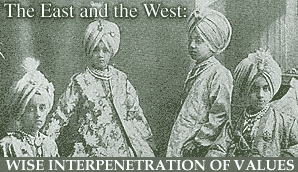Our picture shows the four sons of the Maharaja of Kaourthala at the beginning of the century. The group makes an agreeable impression as there is something quintessentially noble, gracious and refined in the bearing, countenances and attire of these small princes.
They are true princes, quite authentically Indian. Nonetheless, without detracting from that authenticity, one easily perceives that something from our civilization has profoundly penetrated them and their surroundings.
When two great civilizations meet, the most fruitful outcome from the peaceful relationship that should be established is a wise and balanced interchange of values. Thus both civilizations are enriched while neither loses its authenticity. On the contrary, the worst outcome would be the destruction of one by the other.
The Church does not identify Herself specifically with the civilization or culture of any particular people. It is Her nature to foster the conservation and growth of all that is proper and upright in the most varied of civilizations and cultures as well as to eliminate what is false or evil in them.
Thus, one easily sees how much the Catholic influence tends to promote a judicious interpenetration of values. When this interpenetration is guided by the Church, it results in an essential unity, a unity harmoniously variegated among the different cultures and civilizations. That superior unity, based on the Faith, is called Christian civilization.
If the influence of the Church would have reached its apex in the Eastern nations, everything characteristic, elevated and upright in their civilization and culture would have been preserved. Abominable abuses such as the miserable situation of the pariahs and many workers that coexisted with authentic Eastern values would have been abolished.
The India of today would still have been quite authentic, still imbued with its admirable traditions, but also quite Christian, having profited from acceptance of the best values of the West. The West, in its turn, could have benefited so much from contact with a country such as India!
Before the Second World War, this exchange of values had begun, to some degree between the higher classes of India and the West. Normally, these values would have been diffused into the other social classes soon afterwards.
A characteristic example of this are these small princes. Certainly, they manifest something of the atmosphere from “A Thousand and One Nights,” yet they already have assimilated some of the refinement and nobility of the Western “court air.”
But…the Revolution entered the picture, destroying in India, as in the West, their traditions. It turned them against everything authentic and organic in their culture, and, under the pretense of correcting abuses, it is constructing a cosmopolitan and inorganic nation, transferring the often excessive authority of the maharajas to the despotic rule of the machine, bureaucracy and propaganda.
Has this been a benefit or detriment for India? This question, while providing an opportunity for endless discussions, would have the drawback of deviating our attention from another much more interesting problem: Why did that country not follow the path toward a wise interpenetration of values that, in at least some ways, it had begun to pursue?


